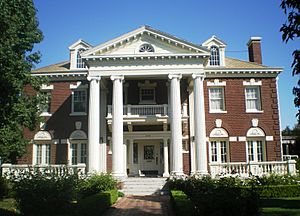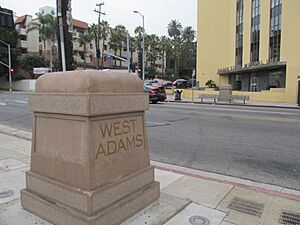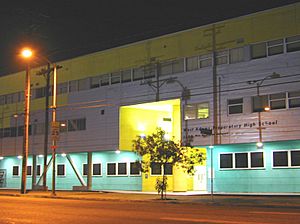West Adams, Los Angeles facts for kids
Quick facts for kids
West Adams
|
|
|---|---|

|
|
| Country | United States |
| State | California |
| County | Los Angeles |
| Time zone | Pacific |
| Zip Code |
90018
|
| Area code(s) | 213/323 |
West Adams is a cool neighborhood in the South Los Angeles area of Los Angeles, California. It's famous for its many old and beautiful buildings, including amazing mansions. You can find several special zones here called Historic Preservation Overlay Zones that help protect these historic places.

Contents
Journey Through West Adams' Past
West Adams is one of the oldest neighborhoods in Los Angeles. Most of its buildings were built between 1880 and 1925. This includes the famous William Andrews Clark Memorial Library. Rich people like railroad boss Henry E. Huntington and industrialist Hulett C. Merritt helped build West Adams.
It used to be the wealthiest part of the city! It was full of grand Victorian mansions and strong Craftsman bungalows. Many business people from Downtown lived here, along with professors from the nearby University of Southern California.
Early Days: 1880s to 1890s
In 1887, a newspaper called the Los Angeles Herald announced a new neighborhood, St. James Park. It was planned to have a stone entrance like the famous Arc de Triomphe in Paris. People expected it to be surrounded by the most expensive homes on the coast.
A couple named George King and his wife gave the park land to the city. They did this to remember their many trips to London. The private community of Chester Place was built in 1889. On October 24, 1901, a wealthy person named Edward L. Doheny bought a house there for a lot of money.
In 1890, "St. Margaret's School for Girls" moved to Los Angeles from Pasadena. The school opened on October 1, 1890, at 23rd and Scarff Streets. It used the empty Marlborough Hotel building and changed its name to the "Marlborough School for Girls." The school stayed in West Adams for 26 years before moving to Hancock Park in 1916.
Growing Pains: 1900s to 1910s
In 1906, people in the "fancy West Adams" area had a water problem. A new pipe from the Ivanhoe reservoir wasn't ready in time. This new reservoir was planned to hold almost a billion gallons of water!
Later that year, a reporter noticed that more and more apartment buildings were being built. They were starting to appear in areas that used to have only big homes. One of the nicest apartment buildings was designed by Thornton Fitzhue. It was built on the south side of St. James Park.
In 1909, another apartment building was finished in St. James Place. It had an entrance on Scarff Street. This building had four apartments, each with seven rooms. It was a big investment at the time.
In 1913, a newspaper announced that the Monarch Hotel would be built in the "fashionable residence district" of West Adams. By 1916, the Los Angeles Times said the area was "already known for its private parks and handsome homes."
At that time, important residents worked to improve Adams Boulevard. They convinced 35 other residents to help pay for it. The old street paving was replaced with a smooth asphalt surface. Adams Boulevard became 65 feet wide. It had pretty islands in the middle with flowers, shrubs, and tall palm trees. New streetlights were also installed, just like the ones in Chicago. Adams Boulevard became a "magnificent" and "popular" drive in Los Angeles.
Changing Times: 1920s to 1930s
In 1921, the Automobile Club decided to build its new main office at Figueroa and Adams. Architects designed a building with a "Spanish design." It was meant to be a "distinctive structure for the West Adams district."
In 1925, silent movie star Ramon Novarro bought a home in "the exclusive West Adams district." He spent a lot of money making it even nicer.
In 1927, during the time when alcohol was illegal (called Prohibition), police found a large illegal alcohol making place. It was hidden in a "luxurious fourteen room mansion" at 2234 Adams Street.
In 1931, during the Great Depression, a group called the "West Adams Relief Committee" helped people. They gave work to twenty men for ninety days. Married men with families who lived in the area and were registered voters were paid $2 a day.
By 1937, West Adams was still seen as elegant, but some parts looked a bit worn. A newspaper wrote that places like St. James Place and Chester Place were once very aristocratic. They showed the wealthy past of Los Angeles, and still had some of that elegance.
New Neighbors: 1940s to 1950s
Around this time, African-American families began moving into West Adams. Famous residents included Golden State Mutual Life Insurance Company president Norman O. Houston, actress Hattie McDaniel, and civil rights activists John and Vada Sommerville. Other stars like Louise Beavers, Johnny Otis, Pearl Bailey, and Ethel Waters also lived here.
In December 1945, some white residents tried to stop Black residents, including Hattie McDaniel, from living there. McDaniel organized meetings to plan for the court case. About 250 people came to support her in court. The judge, Thurmond Clarke, visited the neighborhood himself. The next day, he threw out the case. He said that Black people should have "the full rights guaranteed them under the 14th Amendment." This case helped set an important rule. It later influenced a 1948 Supreme Court decision. This decision said that state courts could not enforce rules that stopped people from buying homes because of their race.

In 1949, the main building for the Golden State Mutual Life Insurance Company opened. This building was designed by architect Paul Williams. It was called "the finest building to be erected and owned by" African-Americans in the country.
Freeway Changes: 1960s to 1970s
Starting in 1961, a big change came to West Adams. The ten-lane Santa Monica Freeway (Interstate 10) was built right through the heart of the neighborhood. This freeway runs east to west, just north of Adams Boulevard.
Building the freeway meant many homes in West Adams were taken and torn down. This included several mansions owned by African Americans. Many residents had to move. A newspaper reported that the freeway could have avoided the "Sugar Hill" section (a nickname for a wealthy Black area). But to do so, it would have cut through areas around USC where college fraternities and sororities were. The college areas stayed, and Sugar Hill did not. This shows how freeway routes often affected African American communities more.
In 1971, Los Angeles Metropolitan Medical Center opened. It was the city’s first hospital owned by Black people. It was a very important part of the West Adams community in the 1970s and 80s.
Modern West Adams: 1980s to Today
In 2000, a Craftsman-style house built in 1911 received a grant to help preserve it. This house was the Alpha Gamma Omega sorority house in West Adams.
In 2004, homes were torn down in West Adams to make way for a new high school. A newspaper reported that a "century-old neighborhood of houses and businesses" was removed for the $130 million school. West Adams Preparatory High School opened in 2007, costing $176 million.
In 2007, the city approved a plan to improve the streets of West Adams. This included putting up four "gateway markers" at the corners of Adams Boulevard and Western Avenue, and Adams Boulevard and Vermont Avenue. Also, 58 magnolia trees were planted along Adams Boulevard, making the area even prettier.
In 2011, a newspaper wrote about neighbors working together to fight crime. They were determined to protect their "graceful streets of century-old bungalows" and beautiful lawns.
In 2016, Karen Bass, who is now the mayor of Los Angeles, said that people are often surprised by the beautiful homes in West Adams. They don't expect to see such lovely houses in the neighborhood. That same year, an empty West Adams Hospital building was turned into a temporary art gallery.
Exploring West Adams' Location
How Los Angeles Defines Neighborhoods
Starting in 2000, a group called the Eighth District Empowerment Congress began a project. They wanted to identify and name the different communities within their area. After a lot of research and community meetings, sixteen neighborhoods, including West Adams, were suggested to the City Council in 2001. They were approved in 2002.
At that time, the city was told to put up "West Adams" neighborhood signs on Vermont, Western, and Adams Boulevards.
West Adams is bordered by Western Avenue to the west and Vermont Avenue to the east. To the south is Jefferson Boulevard, and to the north is the Santa Monica Freeway.
You can also see large concrete "gateway markers" at Western and Adams, and Vermont and Adams. These markers help show where the neighborhood begins.
Amazing Historic Districts
More than 70 places in West Adams have been recognized as important historic sites. They are listed as Historic-Cultural Monuments, California Historical Landmarks, or on the National Register of Historic Places.
Because of their amazing old buildings, West Adams has several Historic Preservation Overlay Zones. These zones help protect the special architecture.
(listed in alphabetical order)
- Harvard Heights
- Lafayette Square
- Jefferson Park
- Menlo Avenue-West Twenty-ninth Street Historic District
- North University Park Historic District
- Twentieth Street Historic District
- Van Buren Place Historic District
- Western Heights
- West Adams Terrace
Unique Homes and Neighborhoods
West Adams has one of the largest collections of historic houses and smaller mansions west of the Mississippi River. You can find many different architectural styles here, such as:
- Queen Anne
- Shingle
- Gothic Revival
- Transitional Arts and Crafts
- American Craftsman/Ultimate Bungalow
- Craftsman Bungalow
- Colonial Revival
- Renaissance Revival
- Mediterranean Revival
- Spanish Colonial Revival
- Mission Revival
- Egyptian Revival
- Beaux-Arts
- Neoclassical
West Adams is also home to the only existing Greene and Greene house left in Los Angeles!
Kinney Heights
Kinney Heights was built around 1900 by a developer named Abbot Kinney. It was a suburban area with large, wealthy Craftsman-style houses. These homes had cool features like "beveled-glass china cabinets, marble fireplaces and mahogany floors." It was easy to get to downtown by streetcar, so many upper-class families moved there.
Twentieth Street Historic District
The Twentieth Street Historic District has a row of bungalows and Craftsman-style houses. You can find them on the south side of 20th Street, in the 900 block.
Who Lives in West Adams?
In 1985, West Adams was mostly a "Black middle-class area." But it was also becoming home to more Latino and Korean families. Plus, there was a mix of people from Hungary, Poland, and Japan, along with students from USC and a growing number of young professionals and gay people.
In 2007, it was noted that African-American gay people were moving to West Adams. They were choosing it over the more expensive and changed area of West Hollywood.
In 2014, a newspaper said that after a recent wave of Latino immigration, young professionals were buying homes in the neighborhoods west of USC. This included the "stately Victorian and Craftsman mansions of West Adams" and the "smaller Craftsman bungalows" of Jefferson Park.
According to Mapping L.A., in 2000, the most common backgrounds were Mexican (29.2%) and Salvadoran (5.7%). Most people born outside the U.S. came from Mexico (37.4%) and El Salvador (25.1%).
Schools in West Adams
Here are some of the schools you can find in the West Adams neighborhood:
- 32nd Street / USC Performing Arts Magnet, LAUSD, 822 W. 32nd St.
- John W. Mack Elementary School, LAUSD, 3020 S. Catalina St.
- Norwood Street Elementary, LAUSD, 2020 Oak St.
- Vermont Avenue Elementary School, LAUSD, 1435 W. 27th St.
- Camino Nuevo Elementary No. 3, Charter, 1723 Cordova St.
- West Adams Preparatory High School, LAUSD, 1500 W. Washington Blvd.
Fun and Parks
- Loren Miller Recreation Center, 2717 Halldale Avenue
- Richardson Family Park, 2700 S. Budlong Avenue
Getting Around West Adams
The Metro E Line train goes from Downtown Los Angeles to Santa Monica. It has stations in West Adams: Vermont/Expo and Expo/Western. This makes it easy to travel!
Cool Places to Visit
- Forthmann House – 1102 W. 28th Street. This house was named a Historic-Cultural Monument on October 4, 1972.
- Frederick Hastings Rindge House - 2263 Harvard Boulevard. It became a Historic-Cultural Monument on February 23, 1972.
- John B. Kane Residence - 2122 Bonsallo Avenue. This home was named a Historic-Cultural Monument on June 12, 1990.
- Ray Charles Offices and Memorial Library - 2107 Washington Boulevard. This place was recognized as a Historic-Cultural Monument on January 21, 2004.
Famous People From West Adams
(in alphabetical order)
- Pearl Bailey, actress
- Louise Beavers, actress
- Busby Berkley, choreographer
- Ben Carter, actor
- Ray Charles, singer
- Clementina D. Griffin, school principal, aviator
- Lionel Hampton, musician
- Leila Holterhoff, singer, linguist, psychoanalyst
- Norman O. Houston, president of Golden State Mutual Life Insurance Company
- Joe Louis, boxer
- Little Richard, singer
- Hattie McDaniel, actress, the first African-American to win an Academy Award.
- Tim Moore, comedian; star of CBS-TV's situation comedy, Amos 'n' Andy.
- Ramon Novarro, silent screen star
- Ivy Pochoda, author
- Ethel Waters, actress
West Adams in Books and TV
- Visiting... with Huell Howser Episode 110.
- These Women by Ivy Pochoda




